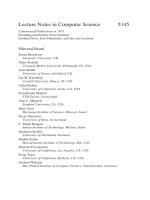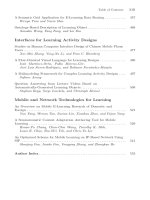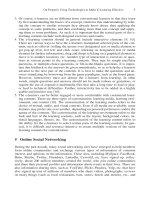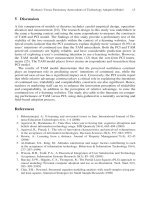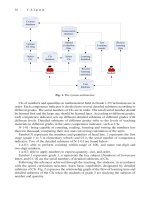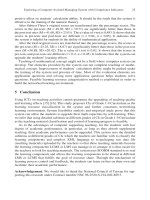Lecture Notes in Computer Science- P81 docx
Bạn đang xem bản rút gọn của tài liệu. Xem và tải ngay bản đầy đủ của tài liệu tại đây (153.26 KB, 5 trang )
A Sociogram Analysis on Group Interaction in an Online Discussion Forum 389
18. Sun, X.: Reflection on traditional education approach of Chinese higher education. Journal
of Finance and Economics S2, 7–8 (2001)
19. Zhao, J.: Group knowledge building in a blended e-learning environment in Chinese
higher education: Modelling, implementation, and evaluation. Unpublished doctoral thesis,
the University of Sheffield (2006)
20. Zhao, J.: Collaborative e-tutoring in an intercultural e-learning course: A case study. In:
Li, H., Shi, G., Wang, Q., Zhao, Y. (eds.) Research in IT and education: A multi-
disciplinary perspective. Beijing Normal University Press, Beijing (2007)
21. Nachmias, R., Segev, L.: Students’ use of content in web-supported academic courses.
Internet and Higher Education 6, 145–157 (2003)
22. Mullen, G.E., Tallent-Runnels, M.K.: Student outcomes and perceptions of instructors’
demands and support in online and traditional classrooms. Internet and Higher Educa-
tion 9, 257–266 (2006)
F. Li et al. (Eds.): ICWL 2008, LNCS 5145, pp. 390
–
397, 2008.
© Springer-Verlag Berlin Heidelberg 2008
Another Dimension of Web-Based Learning:
Psychological Bestirring
Zhiwen Wang
Zhejiang Education Institute, 140 Wensan Road, Hangzhou, P.R. China, 310012
Abstract. The concepts of psychological bestirring and psychological dis-
tance in web-based learning situation are proposed. Their significance and
effects are examined. An online learning performance model is constructed
which employs psychological bestirring as a new factor independent of the
factor of information stimulation. Logistic equation and curve is suggested as
its fundamental mathematic model. The model was then used to explain the
restriction of psychological distance on the usually overestimated advantages
of distance education, especially the massive scale and the asynchronous
learning opportunity. It is also argued for that the web-based learning
framework provides the highest potential to enhance psychological bestirring
among different forms of non-face-to-face learning, because of its close in-
tegration with BBS, chat room, email, instant messaging, blog and other
growing internet-based interactions. Some suggestions drawn out of practice
are also presented to make better use of psychological bestirring in web-based
learning situation.
Keywords: Web-based learning, Psychological Bestirring, Psychological Distance,
Logistic Curve.
1 Foreword
Web-Based learning is attracting great attention from academia and society as well as
huge allocation from the state and local education authority. More and more courses
and other learning materials are been put on the Internet and an effective returning is
expected. Most attention and allocation are put into the infrastructure construction,
platform developing, online course design and other learning information resources
accumulating. But the returning is very far from being expected. When we put our
almost infinite enthusiasm on the technology and information resources, have we ig-
nored some other important dimension independent of technology and learning
information?
This paper based on the observing and practice of online (distance) learning, pro-
poses and discusses the concept of psychological distance and psychological bestirring
in web-based learning situation, as well as their significance, effects and probably
applications.
Another Dimension of Web-Based Learning: Psychological Bestirring 391
2 Psychological Distance, Bestirring and Online Learning
Performance Model
2.1 Psychological Distance
We here propose a new concept, which is called psychological distance between
learner and instructor or among peer learners. Correspondently, when we design and
value online learning or web courses, we can then take a new dimension into account.
The term “psychological distance” was increasingly used or mentioned in psy-
chology or pedagogy literature recently. Yoav, Nira, and Yaacov used eight experi-
ments based on the Implicit Association Test (IAT; A. G. Greenwald, D. E. McGhee, &
J. L. K. Schwartz, 1998) to demonstrate an association between words related to con-
strual level (low vs. high) and words related to four dimensions of distance (proximal
vs. distal): temporal distance, spatial distance, social distance, and hypotheticality.
They also concluded that all of them are forms of psychological distance [1]. Rodney R.
Cocking and K. Ann Renninger put psychological distance as a role in development
theory in which “psychological distance is conceptualized as either the distance be-
tween what the learner understands and what still has to be understood (intrapsychic),
or ways in which others adjust information for the learner in order to be fully com-
prehended (interpsychic)”[2]. Wheeler and Steve Explored the nature of psychological
distance in distance learning and identified some student support issues[3]. TEFL
Studies refered psychological distance as “to the learner's overall psychological set
with regard to the target language and its community” and “determined by factors such
as language shock and motivation”[4].
But here we define psychological distance in web-based learning situation as “a
perceivably social space of learner with his or her instructor (e-moderator) and learning
peers”. Obviously, compare to physical space or distance, this dimension or factor is
more subjective or personalized.
In other words, here psychological distance is something like feelings and emotions
towards other social partners. Learner perceives himself (or herself) be recognized,
regarded by other ones around. He could be acknowledged, admired, encouraged. But
He could also feel the peer pressure, competition, doubts, criticism and even contempt.
All these feelings contribute to the atmosphere of his learning and take effects on
learner himself.
2.2 Psychological Bestirring
Not every psychological effect is positive to learning, but some do play a strong posi-
tive role in learning process and promote learning results. We might as well call those
making positive effects as psychological bestirring factor. Knowing peers are working
hard will help learner to overcome indolence and reject temptation. It should be indi-
cated that some of the effects are very implicit, especially those of between peers. For
example, competitive awareness between talent students, which may stimulate them
pay more attention and effort on their learning. Generally speaking, the shorter the
psychological distance, the stronger the psychological bestirring factor.
392 Z. Wang
Learner
Machine(Platform,
Software˅
Instrutor
Peers
Information
(Learning Material)
Fig. 1. Learner’s environment and Psychological Interaction
2.3 Examining the Learning Environment from the New Dimension
Now let us examine the online-learner’s environment (Fig. 1) again. The left parts
include devices (hardware), Platform, other software and the information as learning
materials, which can perform human-machine interaction with learner. The right parts
are instructors (may include managers, e-moderators ) and learning peers. They per-
form physiological interaction with learner, and co-construct learning organization and
correspondent learning atmosphere.
We notice that when the synchronal (unison pacing) teaching and learning in tradi-
tional classes are strongly criticized, we have probably ignored an important advantage
of it. It is that learners are really in a compact learning community. There is always a
very short physiological distance. Even though, the diverse of bestirring factor are
having strong effects on the learning. Examples include: Some pupils have no interests
and poor performance in some subjects simply because they don’t like the teacher
(They could even admit that the teacher did teach the subject content well), and con-
trariwise, they feel their teacher doesn’t like them too; some pupils specially devote
into particular subjects because they perceive themselves cared and highly regarded by
the teachers. Most people have the experience that during learning, their performance
of a particular subject is self-assessed by comparing with those of their peers rather than
by the measurement of their absolute degree of the subject content mastering.
In the online learning situation, we can use the similar viewpoint of the learning
environment. The transmission and presentation technology of information did be
shortening and even spanning across the physical distance, including geographic and
time distance. But it absolutely doesn’t mean the physiological distance in the learner’s
learning process has been stepped across spontaneously. The existence of this
physiological distance could become a huge barrier from promoting the result of
non-face-to-face learning. While more and more learning materials and web-courses
are being put online, include: course pages (html), instruction video with synchrony
integrated electronic slides (SMIL Streamed Media), BBS forums, automatic checking
tests, and even some good subject-related learning tools (software), we may suppose
that everything is ready but waiting learners wherever and whenever to log in and to
complete learning self-motivated. But the fact is much far away from our expectation.
Most potential learner will never click your web. Some may scan your homepage with
minutes and then give up. The hard work preparing the learning material cannot get due
returning. There could be different causes to degrade the performance of the online
Another Dimension of Web-Based Learning: Psychological Bestirring 393
learning. But we believe, in a lot of cases, the lack of psychological interaction or the
existence of psychological distance could be a more important reason.
2.4 Online Learning Performance Model
Therefore, we suppose that, for most people, there have been an implicated online
learning performance model that employs the learning information stimulation (about
subject content) dimension as the unique factor impacts the learning results. Using E to
denote the effects (performance) of learning, id (information distance) to denote the
information distance or the dimension of the validity of the learning information de-
livering, the model can be described as in following formula (1):
E = f ( id )
(1)
Now we add psychological distance as the other dimension which independent of id,
the improved model should like formula (2):
E = f ( id, pd )
(2)
Here pd denotes the psychological distance between learner and his instructor and
learning peers. The improvement of this dimension could include proper organization
of learning communities (class, group), and construction of interaction, cooperation,
competition, discussion and other learning atmosphere.
In this model, the reduction of both id and pd will bring on the increasing of E.
People may prefer an increasing function. So we can introduce information stimulation
(i) to instead of id, and psychological bestirring (p) to instead of pd. Then the formula
should transform into formula (3):
E = F ( i, p )
(3)
And formula (3) will be an increasing function. The enhancement of both i and p will
bring on increasing of E.
2.5 Borrowing of Logistic Model and Curve
For any particular learning unit (or course) or task, the learning effect (achievement of
learning objectives) should have its limitation. Information stimulation should have
accumulating effects, and psychological bestirring could promote the learning effi-
ciency. So, here we suggest borrowing the logistic model, formula (4), which is often
employed in Item Response Theory [5]:
E =
i)p(exp1
k
•−+
(4)
Where k is a constant denoting maximum E (may be understood as the absolute
achievement of learning objectives), and p acts as a parameter. The curve of the func-
tion will look like that in Fig. 2.
